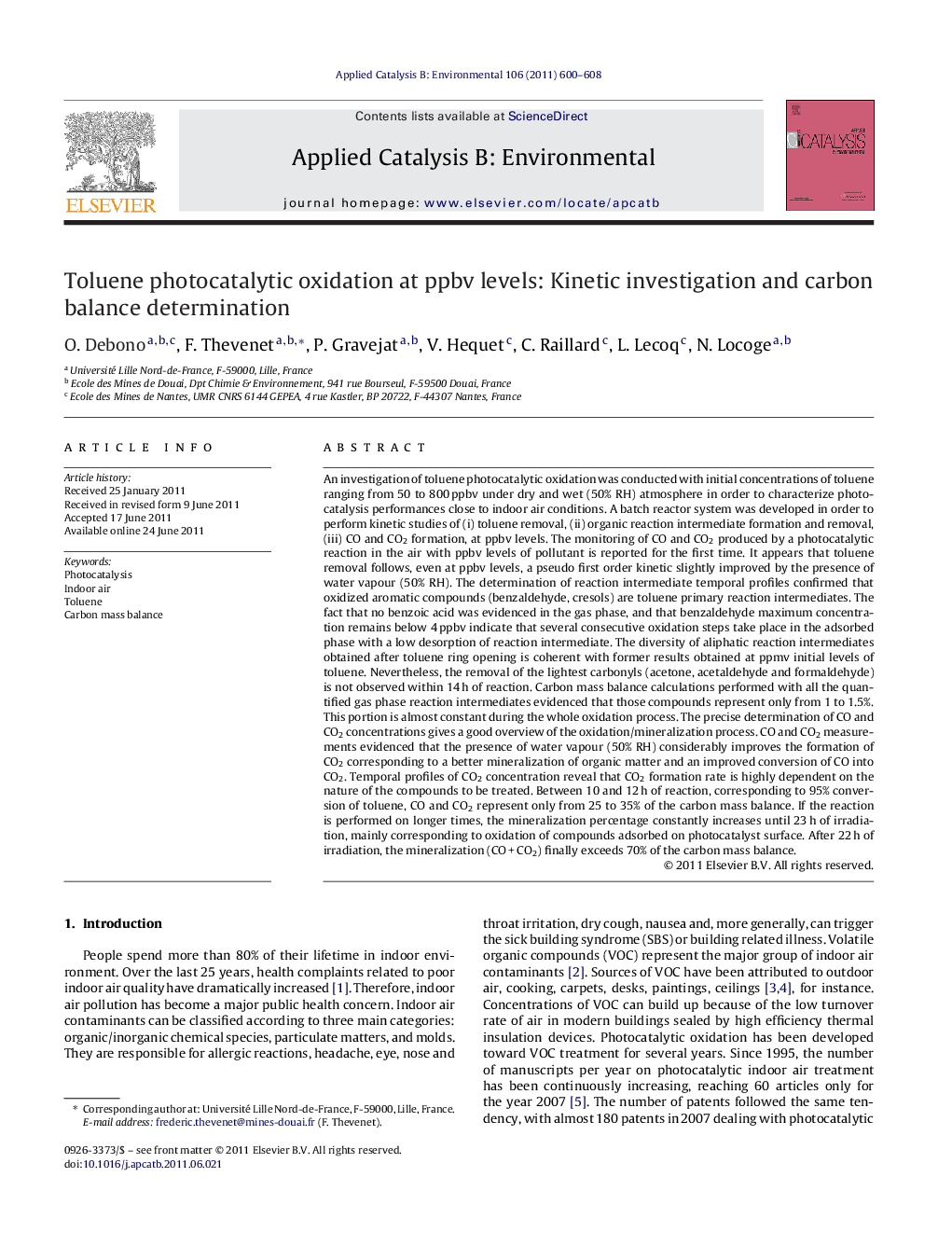| کد مقاله | کد نشریه | سال انتشار | مقاله انگلیسی | نسخه تمام متن |
|---|---|---|---|---|
| 46939 | 46453 | 2011 | 9 صفحه PDF | دانلود رایگان |

An investigation of toluene photocatalytic oxidation was conducted with initial concentrations of toluene ranging from 50 to 800 ppbv under dry and wet (50% RH) atmosphere in order to characterize photocatalysis performances close to indoor air conditions. A batch reactor system was developed in order to perform kinetic studies of (i) toluene removal, (ii) organic reaction intermediate formation and removal, (iii) CO and CO2 formation, at ppbv levels. The monitoring of CO and CO2 produced by a photocatalytic reaction in the air with ppbv levels of pollutant is reported for the first time. It appears that toluene removal follows, even at ppbv levels, a pseudo first order kinetic slightly improved by the presence of water vapour (50% RH). The determination of reaction intermediate temporal profiles confirmed that oxidized aromatic compounds (benzaldehyde, cresols) are toluene primary reaction intermediates. The fact that no benzoic acid was evidenced in the gas phase, and that benzaldehyde maximum concentration remains below 4 ppbv indicate that several consecutive oxidation steps take place in the adsorbed phase with a low desorption of reaction intermediate. The diversity of aliphatic reaction intermediates obtained after toluene ring opening is coherent with former results obtained at ppmv initial levels of toluene. Nevertheless, the removal of the lightest carbonyls (acetone, acetaldehyde and formaldehyde) is not observed within 14 h of reaction. Carbon mass balance calculations performed with all the quantified gas phase reaction intermediates evidenced that those compounds represent only from 1 to 1.5%. This portion is almost constant during the whole oxidation process. The precise determination of CO and CO2 concentrations gives a good overview of the oxidation/mineralization process. CO and CO2 measurements evidenced that the presence of water vapour (50% RH) considerably improves the formation of CO2 corresponding to a better mineralization of organic matter and an improved conversion of CO into CO2. Temporal profiles of CO2 concentration reveal that CO2 formation rate is highly dependent on the nature of the compounds to be treated. Between 10 and 12 h of reaction, corresponding to 95% conversion of toluene, CO and CO2 represent only from 25 to 35% of the carbon mass balance. If the reaction is performed on longer times, the mineralization percentage constantly increases until 23 h of irradiation, mainly corresponding to oxidation of compounds adsorbed on photocatalyst surface. After 22 h of irradiation, the mineralization (CO + CO2) finally exceeds 70% of the carbon mass balance.
Figure optionsDownload as PowerPoint slideHighlights
• Toluene batch photocatalytic abatement on the ppb range.
• Simultaneous investigation: (i) toluene removal, (ii) reaction intermediate, (iii) CO & CO2 formation at ppb levels.
• Gaseous organic reaction intermediates represent only from 1 to 1.5% of the carbon mass balance during the photocatalytic process.
• CO and CO2 formation mainly occur once toluene was removed from the batch reactor: thus mineralization is mainly performed through adsorbed species oxidation.
• CO2 formation is highly improved by 50% RH.
Journal: Applied Catalysis B: Environmental - Volume 106, Issues 3–4, 11 August 2011, Pages 600–608